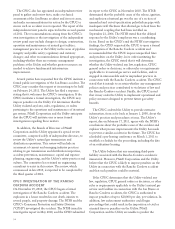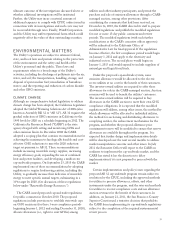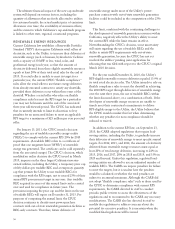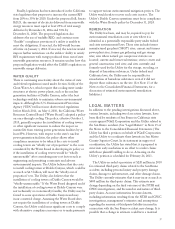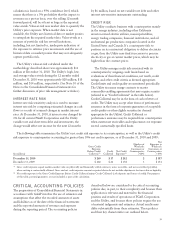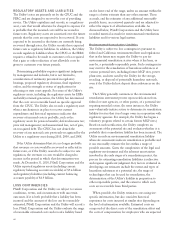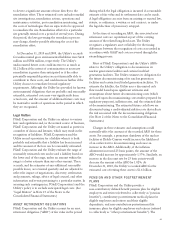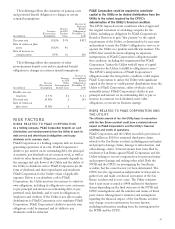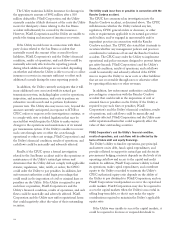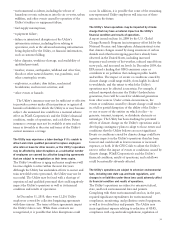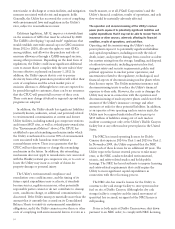PG&E 2010 Annual Report Download - page 48
Download and view the complete annual report
Please find page 48 of the 2010 PG&E annual report below. You can navigate through the pages in the report by either clicking on the pages listed below, or by using the keyword search tool below to find specific information within the annual report.The Utility maintains liability insurance for damages in
the approximate amount of $992 million after a $10
million deductible. PG&E Corporation and the Utility
currently consider it likely that most of the costs the Utility
incurs for third-party claims relating to the San Bruno
accident will ultimately be covered by this insurance.
However, PG&E Corporation and the Utility are unable to
predict the timing and amount of insurance recoveries.
If the Utility records losses in connection with third-
party claims related to the San Bruno accident that
materially exceed the amount it has accrued for these
liabilities, PG&E Corporation’s and the Utility’s financial
condition, results of operations, and cash flows could be
materially adversely affected in the reporting periods
during which additional charges are recorded, depending
on whether and when the Utility is able to record or collect
insurance recoveries in amounts sufficient to offset such
additional accruals during the same reporting periods.
In addition, the Utility currently anticipates that it will
incur additional costs associated with its natural gas
transmission system, including higher costs for operations,
inspection, and maintenance, and costs to perform an
exhaustive records search and to perform hydrostatic
pressure tests. The Utility also may incur costs, beyond the
amount currently anticipated, in response to NTSB or
CPUC orders or requests as the investigations continue, or
to comply with state or federal legislation that may be
enacted that would require the Utility to make various
changes to the operations and maintenance of its natural
gas transmission system. If the Utility is unable to recover
such costs through rates or offset the costs through
operational or other cost savings, PG&E Corporation’s and
the Utility’s financial condition, results of operations, and
cash flows could be materially and adversely affected.
Finally, if the CPUC opens a formal investigation
related to the San Bruno accident and/or the operations or
maintenance of the Utility’s natural gas system and
determines that the Utility did not comply with applicable
statutes, regulations, rules, tariffs, or orders, the CPUC
could order the Utility to pay penalties. In addition, law
enforcement authorities could begin proceedings that
could result in the imposition of civil or criminal fines or
penalties on the Utility. If the Utility is required to pay
such fines or penalties, PG&E Corporation’s and the
Utility’s financial condition, results of operations, and cash
flows could be materially and adversely affected. PG&E
Corporation and the Utility may suffer reputational harm
that could negatively affect the value of their outstanding
securities.
The Utility could incurfines orpenalties inconnectionwith the
Rancho Cordova accident.
The CPUC has commenced an investigation into the
Rancho Cordova accident, as discussed above. The CPUC
will determine whether the Utility violated any law,
regulation, CPUC general orders or decisions, or other
rules or requirements applicable to its natural gas service
and facilities, and/or engaged in unreasonable and/or
imprudent practices in connection with the Rancho
Cordova accident. The CPUC also stated that it intends to
ascertain whether any management policies and practices
contributed to violations of law and the Rancho Cordova
accident. The CPUC may order the Utility to implement
operational and policy measures designed to prevent future
gas safety hazards. PG&E Corporation’s and the Utility’s
financial condition, results of operations, and cash flows
could be materially and adversely affected if the CPUC
were to require the Utility to incur costs or other liabilities
that are not recoverable through rates or otherwise offset
by operating efficiencies or other revenues.
In addition, law enforcement authorities could begin
proceedings in connection with the Rancho Cordova
accident that could result in the imposition of civil or
criminal fines or penalties on the Utility. If the Utility is
required to pay such fines or penalties, PG&E
Corporation’s and the Utility’s financial condition, results
of operations, and cash flows could be materially and
adversely affected. PG&E Corporation and the Utility may
suffer reputational harm that could negatively affect the
value of their outstanding securities.
PG&E Corporation’s and the Utility’s financial condition,
results of operations, and cash flows will be affected by the
terms of future debt and equity financings.
The Utility’s ability to fund its operations, pay principal
and interest on its debt, fund capital expenditures, and
provide collateral to support its natural gas and electricity
procurement hedging contracts depends on the levels of its
operating cash flow and access to the capital and credit
markets. In addition, PG&E Corporation’s ability to fund
its operations, make capital expenditures, and contribute
equity to the Utility as needed to maintain the Utility’s
CPUC-authorized equity ratio depends on the ability of
the Utility to pay dividends to PG&E Corporation, and on
PG&E Corporation’s independent access to the capital and
credit markets. PG&E Corporation may also be required to
access the capital markets when the Utility is successful in
selling long-term debt, so that it may make the equity
contributions required to maintain the Utility’s applicable
equity ratio.
If the Utility were unable to access the capital markets, it
could be required to decrease or suspend dividends to
44


